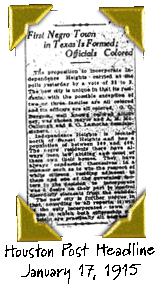

Home
| Contents | Next
Independence Heights: A Window to the Past
Background
| Founders | Annexation
 |
In
1908, black families began to move into an area northeast
of Houston known as Independence Heights. By 1915, it
contained over 600 people. That same year, its residents
voted to become an incorporated city in Texas. This was
significant because this settlement was completely owned
and run by African Americans. In fact, the new city of
Independence Heights was the first African American city
in the state of Texas, according to accounts in the Houston
Chronicle and the Houston Post.
|
 |
|

_____The
citizens of Independence Heights elected attorney G.O.
Burgess as the first mayor, established several churches,
raised a city hall, and built a school. The city’s blocks
filled quickly with dozens of black-owned businesses and
homes built by resident contractors.
In Independence Heights, people found a welcoming community
life.
|
|
_____Yet,
what makes Independence Heights historically significant
has just as much to do with the ways in which its history
and people were typical as it does with the ways in which
they were unique. The stories of the city and its citizens
reflect many of the early twentieth century experiences
of African Americans throughout the South. In this way,
the history of Independence Heights serves as a window
through which we can glimpse part of the African American
experience during the first half of the 20th century.
_____The
Reconstruction era after the Civil War ended set the stage
for the birth of Independence Heights. Houston’s African
American slaves first learned of their emancipation when
General Gordon Granger landed in Galveston, Texas on June
19, 1865. In Texas, this day is still celebrated as “Juneteenth.”
Following Granger’s arrival, freed slaves poured into
the Houston area from plantations in nearby Brazoria and
Fort Bend counties.
|
|
_____Freed
slaves settled throughout the Houston area, rather than
concentrating in a single location, and many acquired
property at a surprisingly rapid rate. By the early
1880s, one-fourth of the black homes in the Third and
Fourth Wards were owner-occupied. The former slaves
who were able to obtain property were typically employed
as skilled workers, shopkeepers, business owners, and
professionals. These career achievements, however, were
not the experience of most former slaves. In 1870 eighty-two
percent of all ex-slaves were employed as domestic,
unskilled, or semiskilled workers.
_____During
the early part of Reconstruction, former slaves made
additional gains on the political front. Houston’s Republican
Party worked tirelessly to register black voters and
in 1869 elected the radical Republican Mayor, Thomas
H. Scanlan. In the same election, several blacks were
elected to the Houston City Council. A few years later,
Scanlan and three African American city councilmen were
reelected to office.
|
Background
| Founders | Annexation
Home
| Contents | Back to Top
Next
|
 |